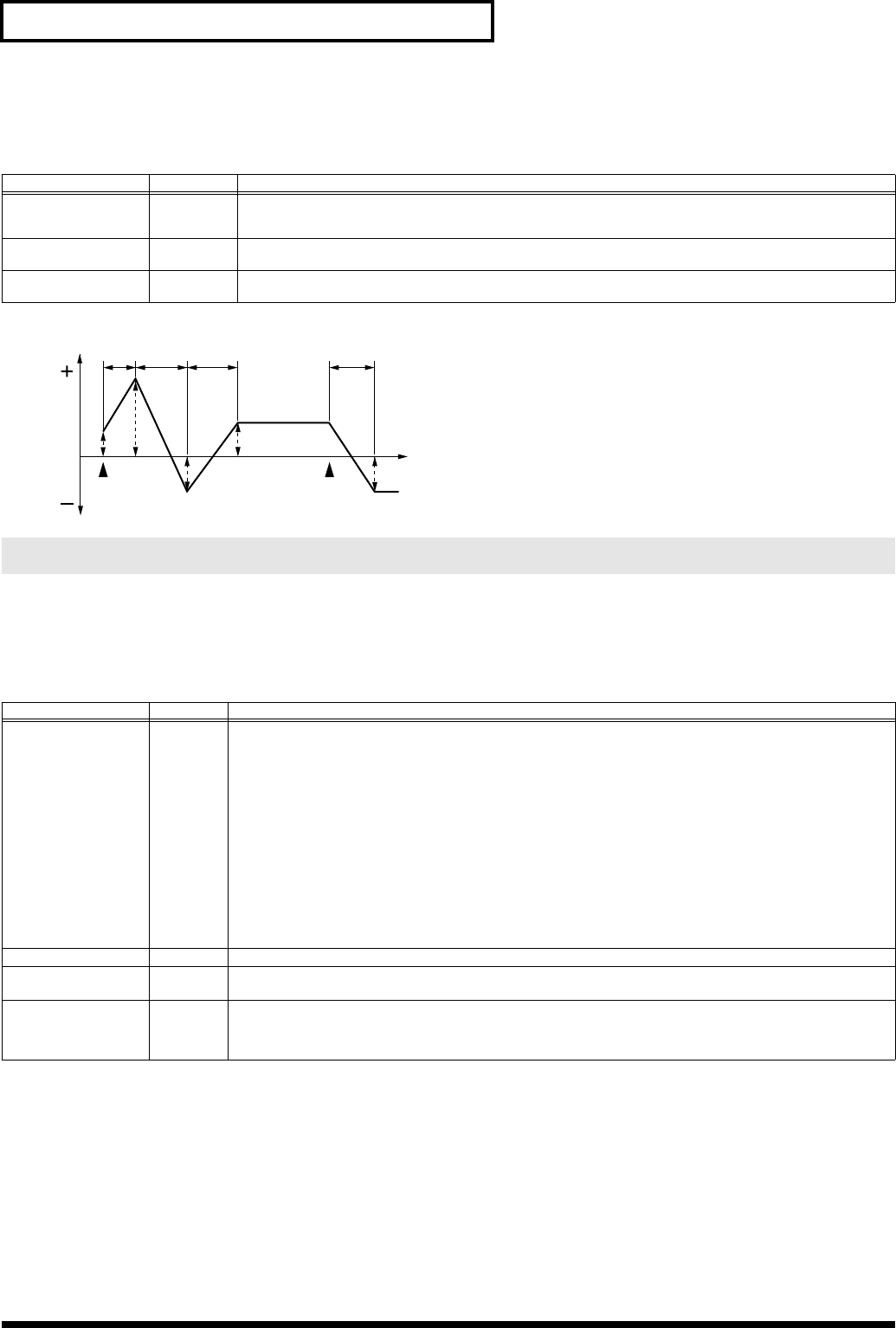
40
Creating a Patch
WAVE PITCH ENV
Parameter marked with a “
★
” can be controlled using specified MIDI messages
(Matrix Control, p. 44)
A filter cuts or boosts a specific frequency region to change a sound’s brightness, thickness, or other qualities.
TVF PARAMETER
Parameter marked with a “
★
” can be controlled using specified MIDI messages
(Matrix Control, p. 44)
Parameter
Value Explanation
P-Env Depth
-12– +12 Depth of the Pitch envelope
Higher settings will cause the pitch envelope to produce greater change. Negative (-) settings will invert the shape of
the envelope.
P-Env Time 1–4
★
0–127
Pitch envelope times (T1–T4)
Higher settings will result in a longer time until the next pitch is reached.
P-Env Level 0–4 -63– +63 Pitch envelope levels (L0–L4)
Specify how the pitch will change at each point, relative to the pitch set with Coarse Tune or Fine Tune.
Modifying the Brightness of a Sound with a Filter (TVF/TVF Envelope)
Parameter
Value Explanation
Filter Type
OFF, LPF,
BPF, HPF,
PKG,
LPF2,
LPF3
Type of filter
OFF:
No filter is used.
LPF:
Low Pass Filter. This reduces the volume of all frequencies above the cutoff frequency in order to round off, or un-
brighten the sound.
BPF:
Band Pass Filter. This leaves only the frequencies in the region of the cutoff frequency, and cuts the rest. This can
be useful when creating distinctive sounds.
HPF:
High Pass Filter. This cuts the frequencies in the region below the cutoff frequency. This is suitable for creating
percussive sounds emphasizing their higher tones.
PKG:
Peaking Filter. This emphasizes the frequencies in the region of the cutoff frequency. You can use this to create
wah-wah effects by employing an LFO to change the cutoff frequency cyclically.
LPF2:
Low Pass Filter 2. Although frequency components above the Cutoff frequency are cut, the sensitivity of this filter
is half that of the LPF. This filter is good for use with simulated instrument sounds such as the acoustic piano.
LPF3:
Low Pass Filter 3. Although frequency components above the Cutoff frequency are cut, the sensitivity of this filter
changes according to the Cutoff frequency. While this filter is also good for use with simulated acoustic instrument
sounds, the nuance it exhibits differs from that of the LPF2, even with the same TVF Envelope settings.
* If you set “LPF2” or “LPF3,” the setting for the Resonance parameter will be ignored.
Cutoff Frequency
★
0–127
Frequency at which the filter begins to have an effect on the waveform’s frequency components
Resonance
★
0–127
Emphasizes the portion of the sound in the region of the cutoff frequency, adding character to the sound
* Excessively high settings can produce oscillation, causing the sound to distort.
Cutoff Keyfollow
-200– +200 Use this parameter if you want the cutoff frequency to change according to the key that is pressed.
Relative to the cutoff frequency at the C4 key (center C), positive (+) settings will cause the cutoff frequency to rise for
notes higher than C4, and negative (-) settings will cause the cutoff frequency to fall for notes higher than C4. Larger
settings will produce greater change.
T1 T2 T3 T4
L3
L4
L2
L1
L0
Note off
Pitch
Pitch Envelope
Time
Note on
JUNO-G_e.book 40 ページ 2006年2月13日 月曜日 午後2時44分


















